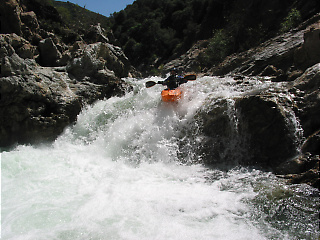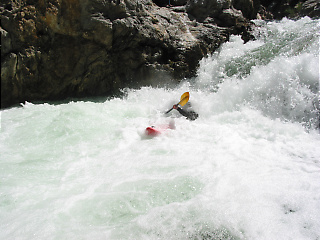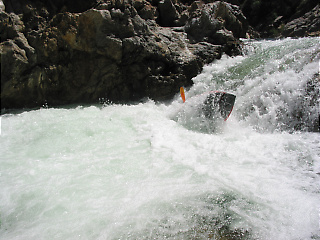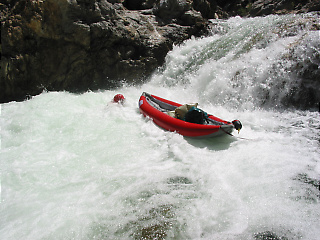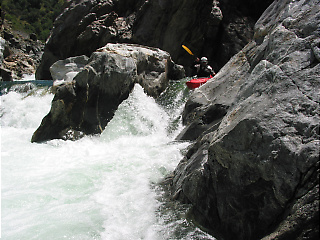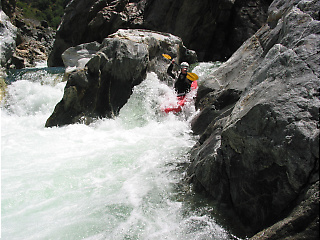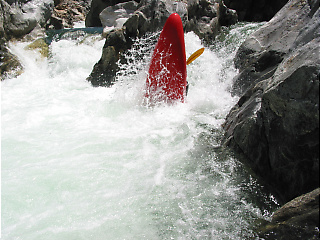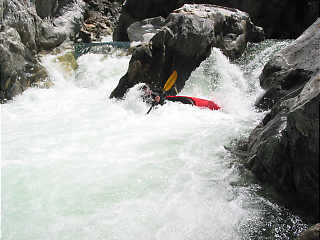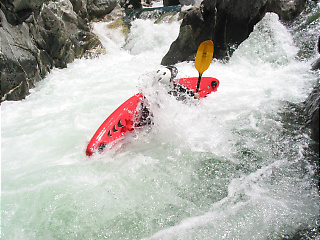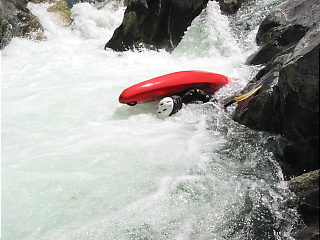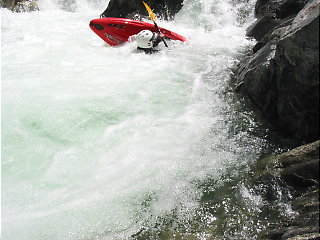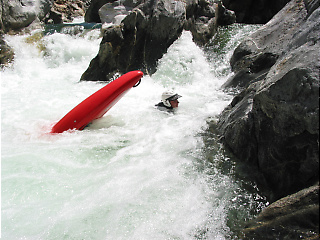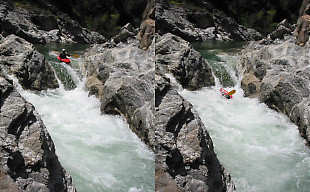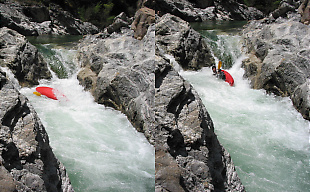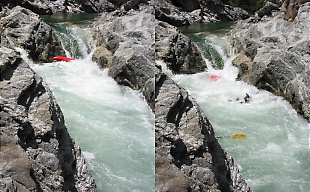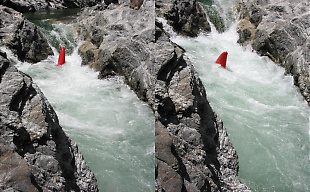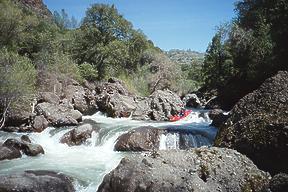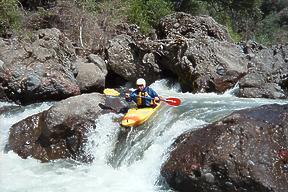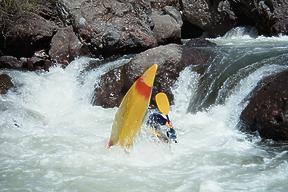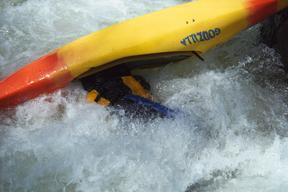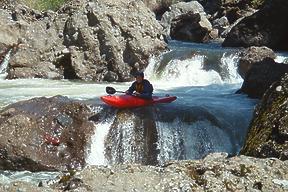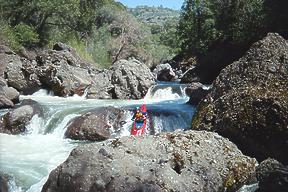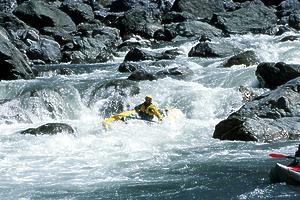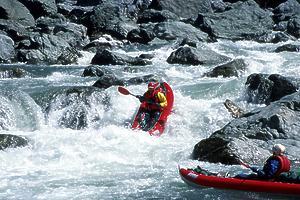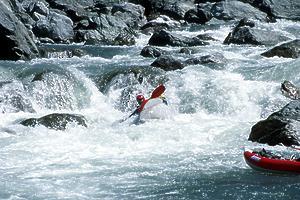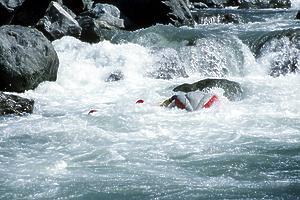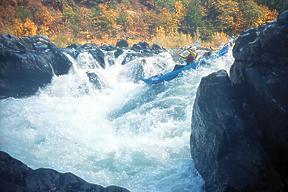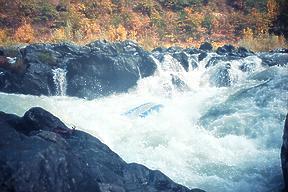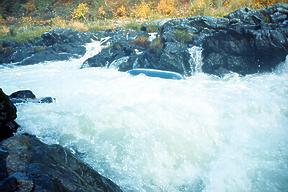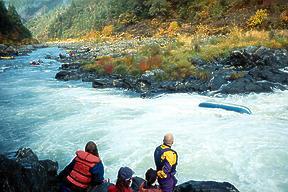| |
Welcome to California Creeks,
an online whitewater guidebook to the Pacific Southwest.
For an antidote, see our Safety Talk.
The Original Carnage Gallery
and Big Boat Carnage Gallery
are two of the most popular pages on this website.
Here is more grist for the mill, fresh cannon fodder,
another bone to throw the dawg, more tupperware for recycling,
a spare paddle for the fish, new sunglasses for the ducks, and so on.
But first, rapid ratings (conspicuously missing from this website until now).
International System for Rating Rapids
This section © 2002 by David Petterson of Calgary Paddlers.
Class I, Easy. Fast moving water with riffles and small waves. Swimming is
pleasant, shore easily reached. A nice break from paddling. Almost all gear
and equipment is recovered. Boat is just slightly scratched.
Class II, Novice. Straightforward rapids with wide, clear channels which are
evident without scouting. Swimming to eddies requires moderate effort.
Climbing out of river may involve slippery rocks and shrub-induced
lacerations. Paddle travels great distance downstream requiring lengthy
walk. Something unimportant is missing. Boat hits submerged rock leaving
visible dent on frame or new gash in plastic.
Class III, Intermediate. Rapids with moderate, irregular waves which may be
difficult to avoid. Water is swallowed. Legs are ground repeatedly against
sharp, pointy rocks. Several eddies are missed while swimming. Difficult
decision to stay with boat results in moment of terror when swimmer realizes
they are downstream of boat. Paddle is recirculated in small hole way
upstream. All personal possessions are removed from boat and floated in
different directions. Paddling partners run along river bank shouting
helpful instructions. Boat is munched against large boulder hard enough to
leave series of deep gouges. Sunglasses fall off.
Class IV, Advanced. Water is generally lots colder than Class III. Intense,
powerful but predictable rapids requiring precise swimming in turbulent
water. Swimming may require must moves above dangerous hazards.
Must moves are downgraded to strongly recommended after they are
missed. Sensation of disbelief experienced while about to swim large drops.
Frantic swimming towards shore is alternated with frantic swimming away from
shore to avoid strainers. Rocks are clung to with death grip. Paddle is
completely forgotten. One shoe is removed. Hydraulic pressure permanently
removes waterproof box with all the really important stuff. Paddle partners
running along stream look genuinely concerned while lofting throw ropes 20 feet
behind swimmer. Paddle partners stare slack-jawed and point in amazement
at boat which is finally pinned by major feature. Climbing up river bank
involves inverted tree. One of those spring loaded pins that attaches watch
to wristband is missing. Contact lenses are moved to rear of eyeballs.
Class V, Expert. The water in this rapid is usually under 42 degrees F.
Most gear is destroyed on rocks within minutes if not seconds. If the boat
survives, it is need of about three days of repair. There is no swimming,
only frantic movements to keep from becoming one with the rocks and to get a
breath from time to time. Terror and panic set in as you realize your
paddle partners don't have a chance in heck of reaching you. You come to a
true understanding of the terms maytagging and pinballing. That hole that
looked like nothing when scouted, has a hydraulic that holds you under the
water until your lungs are close to bursting. You come out only to realize
you still have 75% of the rapid left to swim. Swim to the eddy? What #%^*#*
eddy!? This rapid usually lasts a mile or more. Hydraulic pressure within
the first few seconds removes everything that can come off your body. This
includes gloves, shoes, neoprene socks, sunglasses, hats, and clothing.
The rocks take care of your fingers, toes, and ears. That $900.00 dry suit,
well it might hold up to the rocks. Your paddle is trash. If there is a
strainer, well, just hope it is old and rotten so it breaks. Paddle partners
on shore are frantically trying to run and keep up with you. Their horror is
reflected in their faces as they stare at how you are being tossed around!
They are hoping to remember how to do CPR. They also really hope the cooler
with the beer is still intact. They are going to need a cold one by the time
you get out! Climbing out of this happens after the rapid is over. You will
probably need the help of a backboard, cervical collar and Z-rig. Even
though you have broken bones, lacerations, puncture wounds, missing digits
& ears, and a concussion, you won't feel much pain because you will have
severe hypothermia. Enjoy your stay in the hospital: with the time you
take recovering, you won't get another vacation for 3 years.
Class VI, World Class. Not recommended for swimming.
And now the pictures.
Arroyo not-so Seco, Mucho Cojones
Hardshell kayakers show how to boof off the left side (orange boat),
or how to run straight down the gut and survive (red boat,
same as the sticky creekin' kayak in scenes below).
Then Tuthill shows how to miss the eddy and go over the drop sideways.
Arroyo not-so Seco, Wide Boats not Welcome
This one doesn't look bad from the top,
probably because it's too steep to see much of anything.
But the hole is deceptively sticky, especially for this creekin' kayak.
Arroyo not-so Seco, Moderate Undercut
We don't even go near this one at high water,
but it was only 400 cfs, so the recirculation didn't go too far.
The tail of this creekin' kayak was pretty sticky, however.
Upper White Salmon WA, Farmlands Section
Photographer: Dale Hosley, 2002
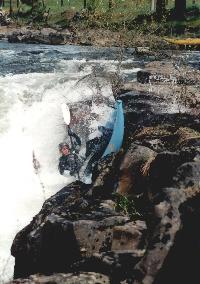
|
Quote:
The 7-8' drop that my brother Ryan had just run is behind him
to the left in the picture. After running the drop and being
momentarily submerged, the hydraulics ejected him from the hole
and shot him up against the left bank. He wasn't there long
before he rolled over and was sucked back into the hole
where both he and his boat were washing-machined for a while
before I dropped my camera and threw him a line to haul him out.
Not a swim he really enjoyed.
|
Deer Creek, Ishi Falls
Ishi Falls, the hardest rapid on lower Deer Creek,
is a complicated four-part drop.
The first part is a narrow slalom,
the second is a tall but forgiving waterfalls,
the third (crux move) is a tall waterfalls with big reversal at the bottom,
and the fourth part is a narrow turbulent slalom,
which many boaters experience at surface level or upside-down.
After seeing one kayaker get munched in the crux falls,
Mike opts for a sneak route to demonstrate his boat's slow hullspeed.
Photographer: Boris Trgovcich, 2002
South Trinity, Grouse Creek Falls
You'd think that by the time someone has boated 90 years like I have,
they wouldn't make stupid mistakes any longer. You would be wrong.
Photographer: Andy Hertz, 2001
Rogue River, Rainey Falls
This drop is a favorite spot for carnage photographers.
Rafts make it upright more than 50% of the time, kayaks less than 10% it seems.
You can judge the distance of the underwater swim by seeing
where the kayak flipped in the second picture, noting the small side falls,
then comparing this falls to the just-surfacing helmet in the third picture.
|
|
Creeks Navigation
Home
Recommended Runs
Map of Rivers
Alphabetic Index
Alphabetic Table
Text Search
Sponsored Links
|
